This is a continuation of a series of posts on the Sony a7RIII. You should be able to find all the posts about that camera in the Category List on the right sidebar, below the Articles widget. There’s a drop-down menu there that you can use to get to all the posts in this series. You can also click on the “a7RIII” link in the “You are here” line at the top of this page.
Truth in advertising: this post is more about the a7RII than the a7RIII, although the newer camera does play a part at the end — here’s a bit of foreshadowing shamelessly designed to keep you reading — ending the post on a downer.
But first, the good news. The a7RII star-eating spatial filtering that takes place at 4 seconds and longer exposures does not occur in continuous low or continuous high shutter modes.
I will show you histograms and spatial frequency plots that are all derived from dark-field (back of body cap) photographs at ISO 640 and 4 seconds, saved in uncompressed raw.
The first is the frequency plot for a single shot shutter mode a7RII (FW 4.00) image with which frequent readers of this blog are all too familiar:
The attenuation in both directions that takes place at higher spatial frequencies is the smoking gun for star-eating.
But if we set the shutter mode to continuous low, we see this:
The periodic behavior in the horizontal direction is indicative of some kind of processing, or some sensor strangeness that happens when the ADCs are run fast, but it’s not star-eating. The vertical direction looks flat as a pancake.
Things look about the same in continuous high shutter mode:
What’s going on?
A look at the histograms provides a clue. First a single shot image:
The green channel has a little ugly combing, but all 14 bits are present and accounted for, and the noise is pretty low.
In continuous low:
The analog to digital converter (ADC) has dropped back to 12-bit precision, and the read noise has increased somewhat.
In continuous high mode:
Looks about the same.
So, the good news is that you don’t have to live with the star munching if you have an a7RII and are a serious astrophotographer. The bad news is that you have to put up with a little more noise and 12-bit precision. As bad news goes, that’s pretty good. The increase in noise is small, and the read noise at ISO 640 provides sufficient dither that you won’t miss those missing bits (at higher ISOs there will be even more read noise, and the increaded noise from the 12-bit conversions will be less significant). There is some question about what that horizontal periodicity means for astrophotography, and I would be interested in hearing from people who use this workaround on real stars.
What does all this mean for a7RIII users? Unfortunately, it means nothing.
Here’s a single shot image from an a7RIII under the same conditions:
Some old ugly behavior.
Now in continuous low:
And in continuous high:
Same old same old.
We can get an idea of why by looking at the histograms. First, single shot:
Like the a7RII one, but the distribution is more ideal.
Now continuous low:
Aha! The ADC is not dropping back to 12 bits.
Continuous high:
Same thing.
So the a7RIII is faster than the a7RII, and doesn’t need to run its ADCs at lower precision in continuous mode. Presumably, it also has time to do the spatial filtering, too.
Win some, lose some.
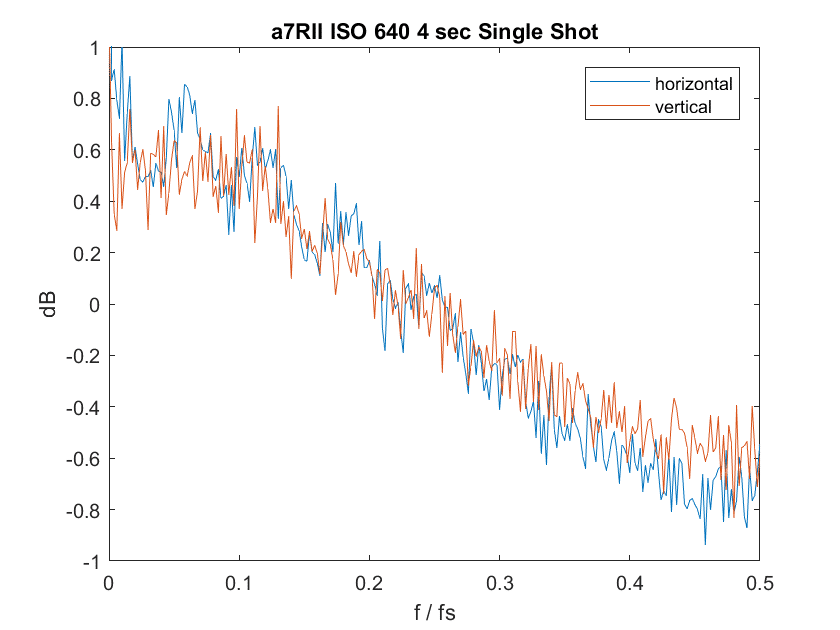
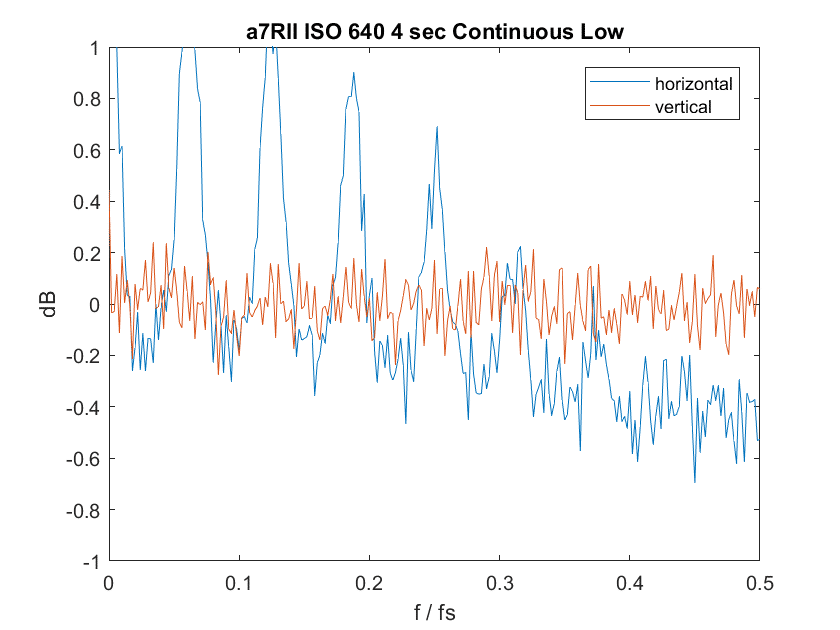




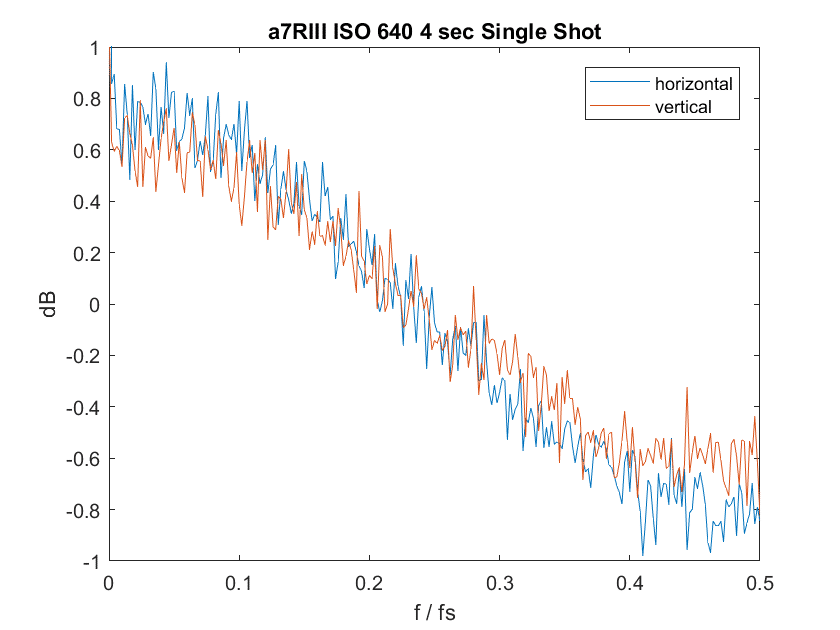
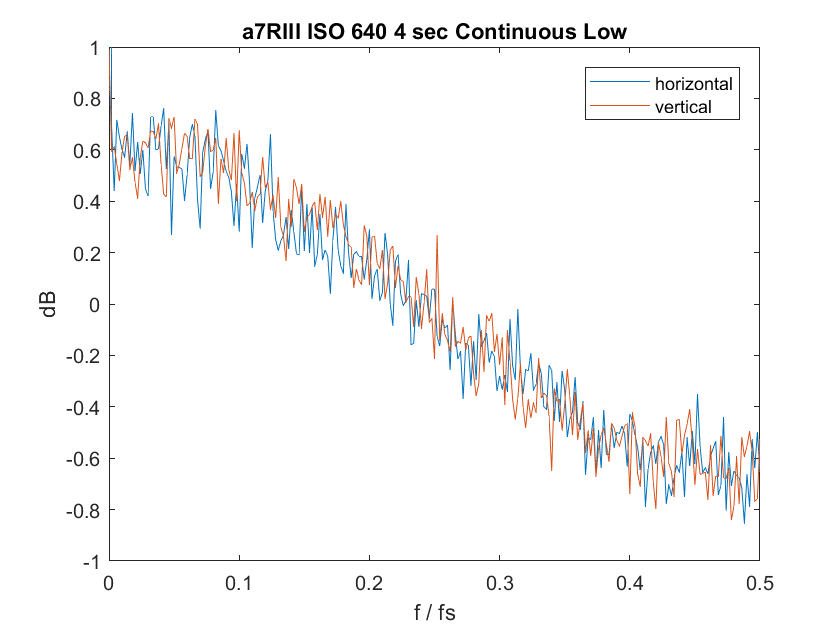
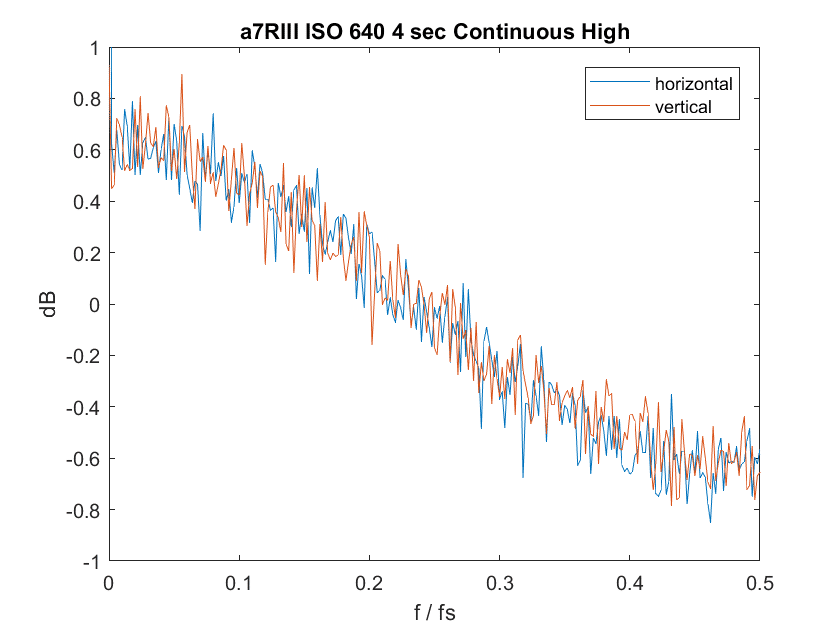



Jack Hogan says
The ‘ugly combing’ looks like 12 bit data subsequently processed at 14/16 bit precision (filtering?, lens corrections?, etc.?), leaving residuals at 14 bits.
Mark Shelley says
That is quite a remarkable find! To be able to work around the star eater problem (at least for non Bulb mode exposures) could be really useful for the astro-community.
That histogram worries me a bit though. Is it possible to check the histogram gaps in continuous mode using your gradient target, for instance.
Scott says
I was wondering if using the pixel shift mode would eliminate the star-eater? I’m guessing the pixel shifting eliminates problematic pixels so maybe the filtering isn’t needed? Possibly Sony doesn’t apply it to that mode??
JimK says
Good idea. Doesn’t help, though.
fred_76 says
Good news Jim
Do you have the opportunity to test the A7S II with the latest firmware against this Continuous Shooting mode trick ?
Fred
JimK says
Sorry, but I don’t have access to that camera. If you shoot the requisite 4-sec dark-field exposures and send me the raw files I will analyze them.
Peter says
I can confirm this trick works on an A7S II with Firmware 2.20
Excellent find!
Jeff Wayt says
I suspect the a7R mark 2 skips the spatial filter process to expedite the extra processing load of continuous modes. The mark 3 has extra processing power, doubling its FPS, focusing speed, etc. so it can afford to pause for a quick star snack, even at 14-bits.
bulb_q says
Does the a7riii bulb mode drop to 12bits like all the other models?
JimK says
Yes.
frankie says
which means the star eat should disappear when bulb mode? for a7r3
for a7r2 we can use continuous low/high to prevent star eat.
JimK says
No, and no. The algorithm is always present in bulb mode, unless something has changed. And the workaround doesn’t help the a7RIII, as I said in the post.
Bryan says
Great news to read. Does this also apply to the A7Sii? That is what I have and am curious. Also would shooting in uncompressed format have any benefit? Thanks.
Bryan
JimK says
Yes.
Not from the standpoint of evading the star-eater algorithm. But uncompressed will have fewer artifacts for single-piel and quasi-single-pixel objects with or without the star eating.
RRockley says
I’m, sorry, perhaps I’m a little dense, but could you please explain exactly what you have to do to get around the star eater problem? Exactly what settings do I need to apply to the camera?
JimK says
Set your shutter to continuous low or continuous high mode.
Mats Danielsson says
On my A7r2 (4.00), Bulb mode does not allow for Continuous modes. This means that this trick can only work for exposure times of 30s and less. So for guided astrophotography, where exposures of several minutes are common, it doesn’t help, unfortunately. 🙁
JimK says
You could stack shorter exposures…
Eric says
I assume all tests above were done with uncompressed RAW? What if I use compressed RAW to force it to 12 bit? Does it get around the star-eater automatically, even in single-shot mode?
JimK says
Compressed raw does not force 12-bit precision, nor does it affect star-eater behavior.
Mirsad Mesinovic says
Hello,
first thanks for this test informations. Im planing buy A7R3 and wanna make pictures for print with milkway. I have amateur question- which camera is better for milkway to get quality images of stacking milkway in tracking – 6D or a7r3? If a7r3 what is ideal settings for tracking+stacking at 35mm and 50mm f/1.4. Thanks
Regards
JimK says
Good questions, but I’m afraid I can’t help you there. I am not an astrophotographer and don’t use Canon equipment anymore. You might try DPR or Fred Miranda.
Raven says
Hello, big thanks to your findings!
Just one question, SONY A7R 2 has playmemories app (extra pay)
there is one app shooting timelapse for this camera.
Is the stopping of star eating effect also apply in this mode?
JimK says
I don’t know.
Bocha says
Hello,
I would like to ask something to you. But firstly, thank you for this blog.
I am interested in astrophotography but also landscape too, I was on a tight budget so bought a used A6300 and 2 lenses just for 350$. In A6300 “post series” I have seen the sentence that says:
“…that is because the ADCs drop down to 12 bits in that mode and they get noisier to boot.”
If A6300 is lowering the ADC resolution does it helps like A7RII, or it doesn’t?
Sorry if I understood wrong or wrote something that doesn’t mean anything, my native language isn’t English so it is a bit hard to understand/use it correctly.
Best Regards…
JimK says
Sorry, but I know nothing about the a6300.
Bocha says
Thanks anyway…
Also if you would like to analyse it, I can send you some photos for analysis.
JimK says
Thanks for the offer, but I don’t have any interest in that camera.